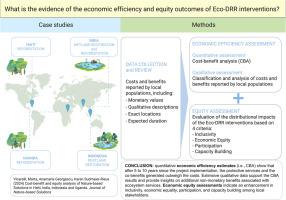Cost-benefit and equity analysis of nature-based solutions in Haiti, India, Indonesia and Uganda
引用次数: 0
Abstract
This study performs an economic efficiency and equity analysis of four recent Ecosystem-based Disaster Risk Reduction (Eco-DRR) interventions in Haiti, India, Indonesia, and Uganda. Our analysis aims at contributing to the development of methodological best practices for assessing both the economic-effectiveness and the distributional impacts of nature-based solutions, with a particular focus on marginalized or underserved communities. Nature-based solutions (NbS) are emerging as possible strategies to mitigate disaster risk while providing additional benefits to biodiversity and sustainable economic growth. However, there is limited scientific evidence about the cost-effectiveness and equity outcomes of NbS. For each ecosystem-based intervention examined we performed an economic efficiency assessment through a quantitative cost-benefit analysis (CBA). Our estimates show that at the 5th year since the project implementation, the interventions in Haiti and India generated positive net benefits, assuming hazard-related yearly losses in properties and GDP per capita in the project areas as low as 0.5 %. We observe the same outcomes in Indonesia and Uganda at the 10th year since the project implementation, assuming yearly losses equivalent to 1 % or higher and adopting a 3 % discount rate. When we include additional benefits from carbon capture and sequestration and pollution reduction the CBA net benefits estimates are positive at the 10th year mark for every discount rate adopted. Extensive qualitative interviews of local stakeholders corroborate the CBA results and provide insights on the numerous additional benefits experienced, which in the future could be measured and monetized if monitored over time. A qualitative analysis of the distributional effects of the interventions was performed to complement the economic efficiency assessment. This equity analysis indicates an enhancement in inclusivity, economic equality, participation, and capacity building among local stakeholders. In particular, the Eco-DRR interventions implemented resulted in significant education, health, safety and economic improvements for women, children, and economically vulnerable members of the local communities.

海地、印度、印度尼西亚和乌干达基于自然的解决方案的成本效益和公平分析
本研究对最近在海地、印度、印度尼西亚和乌干达开展的四项基于生态系统的减少灾害风险(Eco-DRR)干预措施进行了经济效益和公平性分析。我们的分析旨在为开发评估基于自然的解决方案的经济效益和分配影响的最佳实践方法做出贡献,尤其关注边缘化或服务不足的社区。基于自然的解决方案(NbS)正在成为减轻灾害风险的可能战略,同时为生物多样性和可持续经济增长带来更多益处。然而,有关 NbS 的成本效益和公平结果的科学证据却很有限。我们通过定量成本效益分析 (CBA) 对每项基于生态系统的干预措施进行了经济效益评估。我们的估算结果表明,在项目实施后的第五年,海地和印度的干预措施产生了积极的净效益,假定与灾害相关的项目地区每年的财产损失和人均 GDP 低至 0.5%。在印度尼西亚和乌干达,假设每年的损失相当于 1% 或更高,并采用 3% 的贴现率,在项目实施后的第 10 年,我们观察到了相同的结果。当我们将碳捕集与封存和减少污染带来的额外效益计算在内时,成本效益分析的净效益估计值在第 10 年时无论采用何种贴现率均为正值。对当地利益相关者进行的广泛定性访谈证实了成本效益分析的结果,并提供了关于许多额外效益的见解。对干预措施的分配效应进行了定性分析,以补充经济效益评估。这项公平分析表明,当地利益相关者的包容性、经济平等、参与和能力建设都得到了加强。特别是,所实施的生态减灾干预措施使当地社区的妇女、儿童和经济弱势成员在教育、健康、安全和经济方面得到了显著改善。
本文章由计算机程序翻译,如有差异,请以英文原文为准。
求助全文
约1分钟内获得全文
求助全文

 求助内容:
求助内容: 应助结果提醒方式:
应助结果提醒方式:


